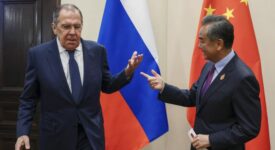During the last days of 2020, the European Union and China finalized a Comprehensive Agreement on Investment (CAI) that they had been negotiating for seven years. In the weeks since, the CAI has attracted a lot of Western commentary – much of it damning. But now that the full text of the agreement is available, it seems that critics may be overstating its importance.
For starters, some argue that the EU is relying too much on the Chinese market to keep its economy growing. But trade and investment data do not bear this out. In 2019, China was only the third-largest market for EU goods exports. The United States remains the EU-27’s most important trading partner by far, followed by the United Kingdom. EU exports to China are actually somewhat lower than one would expect, given that China’s GDP (even at market exchange rates) is now close to 80% of that of the US, whereas EU exports to China are only about 50% of those to the US. Moreover, the relative importance of the US and China as export markets for the EU has not changed much over the past decade. This means that the EU’s transatlantic exports have increased almost as quickly as its trade with China – despite China’s much higher GDP growth rate.
The same is true of the EU’s trade with China’s democratic neighbors. Between 2009 and 2019, for example, EU exports to South Korea increased at almost the same rate as those to China. And the intensity of EU-South Korea trade is twice as high as one would expect, given that the EU-27 economy is about ten times larger than South Korea’s. From a trade perspective, therefore, Europe is not “betting on China.” On the contrary, bilateral economic relations are somewhat weaker than the Chinese economy’s size would imply. This is even more apparent when it comes to bilateral EU-China direct investment. The EU’s direct investment in the US is almost 15 times larger than its investment in China, while Chinese investment in the EU amounts to about one-twentieth of US investment. And bilateral investment flows have recently stagnated at low levels, with no substantial new investment by a Chinese state-owned enterprise in Europe over the past year.
The EU’s new foreign-investment screening mechanism, which is de facto aimed mainly at China, must also be seen in the context of these numbers. Current Chinese investment flows into the EU are around €11.7 billion per year, implying no threat to a €15 trillion economy. And affiliates of Chinese firms employ less than 300,000 workers in the EU, a tiny fraction of the bloc’s overall workforce of about 220 million. Furthermore, a look at the CAI’s details reveals that, belying its name, the agreement is far from comprehensive. The main concrete benefit for European firms is the partial opening of China’s automotive and financial sectors. But the accord’s main provisions reiterate pre-existing commitments or promises of “best efforts” in areas such as regulatory transparency and social standards (including China’s pledge to continue working toward ratifying the Forced Labor Convention). The dispute-settlement mechanism also remains vague, and mainly enjoins both sides to consult and reach an agreement.
Critics of the CAI neglect to mention that the EU had little leverage because investment in Europe is already mostly liberalized. The EU therefore could not offer meaningful improvements for Chinese investors. And if you have little to offer in a negotiation, you cannot expect much from the other side. Under these circumstances, we should not have expected an agreement that addresses every social or human-rights problem Europeans see in China. Lastly, many have criticized the EU’s conclusion of the CAI on geopolitical grounds, for handing China a diplomatic victory just when a new US administration with a more positive transatlantic outlook was preparing to take office. But it is ultimately an international agreement’s substance that determines its geopolitical impact.
We learned this in March 2019, when, to great fanfare, Italy signed onto China’s Belt and Road Initiative (BRI), a transnational infrastructure investment scheme whose official aim is to bolster economic relations between Asia and Europe. At the time, many questioned the geopolitical wisdom of Italy becoming the first G7 country to join the Chinese-led initiative. But reality set in rather quickly. All Italy had done was sign a memorandum of understanding that had no impact on trade or investment, as one would expect from a vague declaration of intent to strengthen economic ties. Disappointment at the lack of tangible benefits has turned a geopolitical victory for China into a defeat, with the same Italian minister who previously championed the BRI now taking a much more critical position toward China.
Likewise, the CAI will be judged a few years from now by its implementation and the concrete steps China takes to fulfill its promises. If European companies do not perceive any improvement, and China makes no progress on labor standards, the CAI might come to be viewed as another empty gesture.
‚The Limits of the EU-China Investment Agreement‘ – Commentary by Daniel Gros – Project Syndicate.







